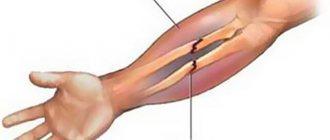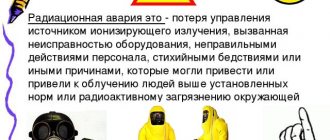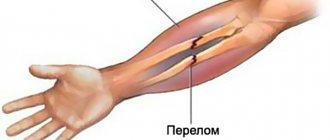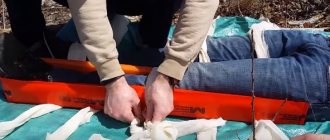What is a thermal burn and why does it happen?
Human skin performs a protective and thermoregulatory function. When exposed to high temperatures, damage and destruction occur.
A thermal burn forms on any part of the human body upon contact with liquids with a temperature of more than 45-49 ° C, hot objects, steam, or open flame. Depending on the factor that caused the injury, the degree, depth of injury and consequences may vary.
- A burn from boiling water can occur when a container with liquid is accidentally tipped over or a person is carelessly immersed in such an environment. In the latter case, the consequences of the accident will be much more serious.
- It is extremely dangerous to get hot oil on exposed skin. The temperature of the substance is always extremely high, and heat transfer is difficult, while a film is formed on the skin that protects the damaged area from cooling, thereby prolonging the time the tissue is exposed to high temperatures.
The thicker the liquid, the more solid particles it contains (for example, vegetables in soup, tea leaves in a teapot, etc.), the longer the contact with the thermal factor and the higher the likelihood of deep damage.
- A burn from an open flame is accompanied by fire of clothing and hair, as well as damage to the respiratory tract and poisoning by combustion products. A sharp decrease in the level of oxygen in the blood contributes to the development and worsening of burn shock.
- When damaged by steam, the depth, speed and area of damage are more serious due to the fact that at a pressure of 5 bar (usual during boiling), the temperature of the resulting condensate is 150 ° C. At the same time, the rate of penetration into tissue increases due to the impact force of the damaging factor. If the burn occurs on the face (which is far from uncommon), then there is a high probability of damage to the eyes, mouth and nose, as well as the respiratory tract.
Hot metals upon contact with the skin instantly destroy the outer epidermal membrane, so the damage is quite serious.
loading…
Most often they are localized in the palm area and occur in case of careless grasping of hot objects - handles of pots, speedos, baking trays. They pose a great threat of limiting the functionality of the limb after healing.
Characteristics of thermal damage
In the International Classification of Diseases (ICD), a thermal burn is damage to the epithelium or deep tissues of the body from a heat source of high temperature (fire, steam, boiling water, hot objects).

The leading place among thermal injuries is occupied by burns from flames - 70%. Injuries due to scalding and contact with electric current account for 25%, under the influence of other factors - up to 5% of recorded cases.
This is interesting: Antiseptics for treating wounds
A thermal burn damages various layers of the skin - from the superficial epidermis to the subcutaneous tissue, and in severe cases to the internal organs. Injuries are classified according to factors of depth and extent of pathology. Complex therapy and long-term recovery are associated with the destructive effect of the damaging factor on the protein involved in cellular renewal.
Severity of thermal burn
The degree of severity is determined by external signs of damage to the skin and underlying muscle structures. A thermal burn can have any of the four known degrees of severity. At the initial stage, they differ in symptoms.
- I degree - injury to the outer layer of skin. The main signs: burning pain, redness, visible looseness of the skin, slight swelling. If the affected area is large, it can cause severe dehydration and painful shock in the victim. In general, it is considered the mildest degree, passing within 5 days.
- Second degree or a burn with blisters (link to article 5) damages the mesodermal layer, and is accompanied by very severe pain, the formation of blisters with liquid, wet wounds, at the bottom of which veins of sintered blood vessels are visible. Symptoms of tissue destruction can appear within 24 hours, so in the first minutes of an incident the severity of the damage can be underestimated. It is dangerous if it involves more than 7-10% of the body (in children under 3 years old, 5% is enough); it heals within two weeks, but is easily infected.
- III degree refers to the number of superficial burns, like the previous two, only under the condition that the papillary zone of the mesoderm is not completely damaged and at least partially reproducing skin appendages are preserved: hair follicles, sebaceous and sweat glands. Such conditions are typical for grade III A: the skin has a chance to recover on its own under favorable conditions, possibly without a scar. In terms of symptoms, it is similar to the previous second degree, only the blister forms very dense, and on days 3-5 it is replaced by a thick brown scab. If all skin structures are damaged, including subcutaneous fat, then we can talk about the presence of a III B degree burn, which is already classified as deep damage and can be treated surgically. The difference between subtypes A and B also lies in the persistence or absence of pain. With a deep burn, the nerve endings are destroyed, and sensitivity in the wound disappears. However, only a doctor can definitively determine the degree.
- IV degree thermal burn affects muscle tissue, ligaments, tendons, and bone structures. The scab on the area of damage is coal-black (charring), there is no pain, but there are signs of increasing burn shock; with a large area of damage, there may be pronounced disturbances in vital functions: pathological type of breathing, heart rhythm disturbances.
In cases of extensive thermal injury, such as from fire and contact with large volumes of hot liquid, burns of varying severity may be present on different areas of the body.
This depends on the difference in skin type (neck, face, crotch, and inner thigh areas are the most delicate) and the duration of contact with the traumatic factor.
First aid and treatment
You need to know how to provide emergency medical care for a thermal burn, what to do in case of a thermal burn, and what rules for treating the surface of wounds must be strictly followed.
First of all, the burned person is assisted in cooling the injury site, which will help prevent more serious injuries and reduce pain. To do this, the burned surface area for first and second degree burns must be rinsed with cold, clean water for 20 minutes. Afterwards, the damaged area must be immersed in water for 30 minutes. Next, apply a bandage of gauze bandage or clean cloth to the surface of the burn, having previously treated the burned area and the skin nearby with an antiseptic.
To prevent burn shock in an injured person, you should give him a warm drink, as it also helps remove toxins that are formed during combustion.
Next, you need to give a painkiller that will help relieve the pain. The victim can be given ibuprofen, novocaine, baralgin or analgin. Novocaine needs to be treated over the entire area of the burned surface of the body.
Thermal burns of the first two degrees can be treated at home, but severe injuries of the third and fourth degrees can only be treated in a hospital under the supervision of doctors.
For treatment, healing dressings are used using ointments such as: levomekol, zinc ointment, rescuer or Vishnevsky ointment. First, you need to disinfect the affected area and its surroundings with 3 percent hydrogen peroxide, then carefully apply a layer of healing ointment or gel and apply a bandage or other breathable and sterile fabric. Drugs for the treatment of burns should be used in strict accordance with their instructions. Sea buckthorn oil and cabbage leaves also help heal burns, but these are folk remedies. Treatment methods for thermal injuries such as burns directly depend on their classification
Emergency determination of the affected area
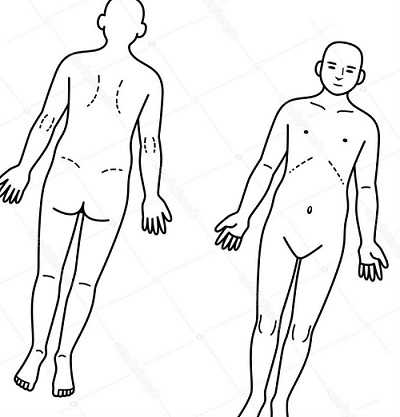
In the article “Severity of Burns,” we told you about several medical methods for determining the area of damage in relation to healthy areas of the body. This is a particularly important indicator that objectively reflects the severity of the injury.
The rule of “nines” helps to quickly determine the percentage of damage to the body; for this, the anatomical parts of the body are conventionally divided into areas equal to 9%:
- head and neck;
- rib cage;
- upper limb;
- stomach.
18% is the back area, lower limb and 1% is the genital area.
It should be noted that for children there are other tables of the percentage of body parts, compiled on the basis of age criteria.
In an emergency situation, it is customary to take into account that the affected area, equal to the approximate size of 10 palms of the victim, is equal to 10% of the body and requires serious medical intervention. This indicator refers to grade II injuries in adults. For first degree, only damage to 80-100% of the body can be fatal.
Deep burns of even a small area (1-2%) require prompt medical attention, since substances released as a result of tissue necrosis enter the bloodstream and lead to toxic damage to the entire body.
There are also the following signs that require seeking emergency help if there is difficulty determining the severity of the injury:
- a burn with blisters in a young child (under 5 years old) or in an elderly person;
- there is no sensitivity on the wound;
- there was a burn to the eyes, face, genitals, internal organs;
- the victim has a deep faint;
- suspected carbon monoxide poisoning;
- associated injuries were received: fractures, bruises;
- a pregnant woman was injured;
- the burn was accompanied by ignition of clothing;
- the victim experiences severe physical pain.
Delayed complications include:
- persistent increase in body temperature;
- signs of purulent inflammation;
- long-term non-healing ulcers;
- increasing weakness;
- increasing dehydration;
- the development of complications from other organs and systems, as well as exacerbation of chronic diseases.
The victim’s condition may worsen significantly during the first three days, so you should carefully monitor negative symptoms and seek medical help if there is any suspicious change. It is also important to follow the recommendations on how to treat a burn received from a doctor.
Risk of complications
The danger arises if a large surface area of the body is affected - more than 10-15%, since there is a risk of dehydration of the body and poisoning with cell decay products. You can determine how large an injury is by following the “rule of the palm”, the area of which is approximately 1% of the total surface of the injured person’s body.
Particular attention should be paid to burns of the face, neck, perineum - areas with delicate skin, the location of important organs. If a small child is injured, an extensive 1st degree burn, treatment is carried out under the supervision of a surgeon, since many processes in a child’s body proceed differently than in adults.
Conditions with the following symptoms cause anxiety:
- dizziness;
- nausea;
- general weakness;
- rapid pulse;
- temperature;
- chills.
Complications rarely occur with minor burns, but if there was a similar injury previously, the body responds to the irritant in a more acute form.
First aid for thermal burns
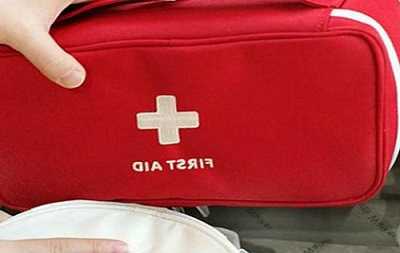
There are a number of rules on how to act in case of damage from high temperatures.
- Eliminate the traumatic factor, stop contact with it. If damage occurs during a fire, the first step is to extinguish the fire on clothing, place the victim as far as possible from the source of the flame, and provide him with access to oxygen.
- If the affected area is under clothing, then you need to get rid of it; the best option is to carefully cut it off with scissors. It often happens that fragments of tissue are fused into the wound; they should not be torn off; this area is cut out, and the clogging particles are removed with a sterile instrument in a medical facility.
- Assess the condition of the victim: presence of breathing, pulse, consciousness. If these signs are absent, first aid should begin with simple resuscitation measures: artificial respiration (mouth to mouth, or mouth to nose through a clean cloth or handkerchief), chest compressions in the ratio: 2 breaths - 15 pressures (if the manipulation is carried out by one person) . Actions must be continued until the pulse returns and respiratory function is restored.
- Stop the thermal reaction as soon as possible. Thermal effects on the skin and tissues persist even after cessation of contact with the traumatic agent. For a superficial burn, the area can be cooled with running water until the burning sensation is completely eliminated. Deep third- and fourth-degree burns are easily infected, so you should not balance the temperature difference with tap water. It is necessary to treat the wound with an alcohol-free antiseptic and apply a clean bandage moistened with cool water.
- If nausea is present, the victim should be placed on his side to eliminate the risk of vomit entering the respiratory tract.
- In case of thermal burn of the upper extremities, foot and lower leg, you should ensure that these parts of the body are positioned above the level of the torso, this will help reduce swelling. It is also necessary to get rid of all factors that interfere with normal blood circulation: rings, bracelets, watches, socks, etc.
- Superficial thermal burns can be treated with chlorhexidine, furatsilin solution, Panthenol and Olazol spray. It is not recommended to immediately use fatty ointments with an antibiotic; they are prescribed only after the cessation of the hyperthermic reaction in the wound at the stage of active granulation.
- The bandage should be applied loosely to prevent compression and blood flow. Do not apply a dry cloth to the wound; you can moisten it with an antiseptic solution.
- Any touching of open wounds is prohibited.
- A bandage is not applied to an intact bladder; it must be carefully treated around the edges with an antiseptic solution. The integrity of the shell must not be damaged.
- The victim should be provided with small, frequent drinks. To restore the balance of electrolytes, you should drink rehydron in a dose of 1 tablespoon at intervals of 10-15 minutes.
- Self-administered pain relief should be carried out in case of severe pain using tablet drugs with established tolerance. Ibuprofen, Nise, and analgin are suitable for these purposes.
- All medications used should be reported to your doctor.
- If the victim feels chills, cover him with a blanket.
First aid
First aid for thermal burns significantly reduces the risk of complications and the duration of treatment.
The first actions should be aimed at:
- to eliminate a heat source that has a pathological effect on the human body;
- Call an ambulance if the burn is extensive or there is deep tissue damage.
Next, you should alleviate the condition of the victim:
- if necessary, remove smoldering clothing, but do not touch the wounds. If the fabric is stuck to the surface of the skin, then the fragment should be cut off, but not torn off from the sore spot;
- Cool the affected area with running water at room temperature and water for 10-15 minutes to prevent the burn area from increasing. The procedure should not be carried out if the wound is deep, the surface of the skin is destroyed, as infection of the body is possible;
- apply a dry sterile cloth to the damaged area; for extensive burns, cover with a cloth ironed;
- offer the victim painkillers available at the pharmacy;
- provide plenty of fluids.
This is interesting: What to do in case of an open fracture with bone displacement
It is equally important to calm the person down and set him up to overcome the situation. It is important for a child to feel the protection and care of loved ones.
First aid for thermal burns briefly
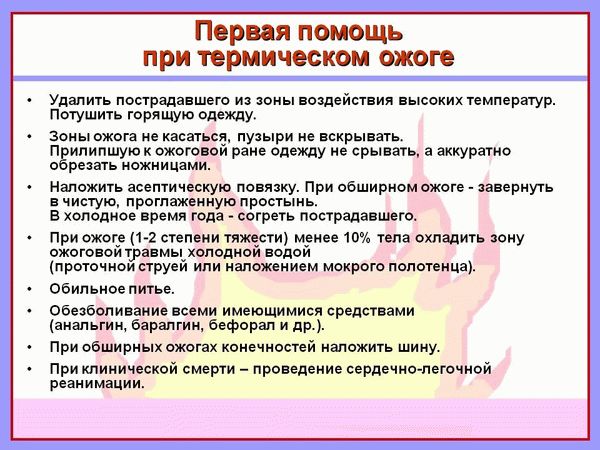
Providing first aid for thermal burns should not include irreparable errors that cause pain and provoke complications for the victim.
Absolutely forbidden:
- touch fresh wounds with your hands to avoid infection;
- apply wound-healing anti-burn agents to the site of injury immediately after injury - their action is beneficial at another stage of treatment;
- lubricate burns with products containing alcohol, as well as brilliant green, iodine - they have a destructive effect, dry out fragile tissues, and increase pain;
- apply fat-containing substances, creams, vegetable oil - a film is formed that disrupts heat exchange;
- cool the affected area by directly applying ice to the wound - the action causes hypothermia, vasospasm, and severe pain;
- wipe the burn with urine - the risk of infection getting into the wound increases, the temperature of the liquid does not have the desired effect;
- open the blisters - the presence of discomfort from blisters with liquid content must be tolerated. As long as the wound is covered with swollen skin, it is protected from environmental bacteria.
First aid should be provided carefully and prudently. Mistakes increase the destructive impact and increase the recovery period after injury.
What to do is strictly prohibited

There are a number of activities that are considered traditional in providing first aid, but do not bring any benefit to the victim, and even, in some way, harm. Next, let's talk about what you absolutely should not do:
- Apply oil, lard, fat, margarine, petroleum jelly and other substances that form a film on the surface of the skin or open wound to a fresh burn. By blocking the access of oxygen, you can significantly reduce natural heat transfer, thereby increasing the pain syndrome and increasing the likelihood of the process deepening.
- Use urine. I would like to say something about this method separately, because many people are firmly convinced that urine is a healing aseptic liquid. The sterility of urine is maintained only if it is inside the bladder; at the moment it passes through the urethra, it is inevitably exposed to infection by microbial flora, which is necessarily present on the sphincter. Even if we theoretically assume that it was possible to avoid contamination, for example, urine was obtained through a catheter or by cystocentesis, it in any case has an acidic reaction and can only have an irritating effect on the wound.
- Apply ice. A sharp change in temperature provokes an increase in shock: peripheral blood circulation around the wound is significantly impaired, cold exposure increases vascular spasm, and the damage process increases.
- Sprinkle with starch, soda or flour. Such measures do not in any way affect the relief of symptoms, but they clog the wound perfectly. At the same time, further diagnosis and determination of the depth of tissue damage is significantly complicated.
- Apply a tourniquet if injury to the limbs occurs. This is not only pointless, but also dangerous. Even with deep burns, the risk of bleeding is zero. Under the influence of high temperatures, the blood in the vessels close to the site of injury coagulates. A pressure bandage can provoke extensive necrosis.
These actions are officially recognized by medical science as completely useless and harmful.
Treatment with folk remedies
Minor damage to the epidermis does not require specific treatment. You can often speed up tissue regeneration using traditional medicine recipes:
- Strongly brewed tea can be used as an antiseptic. The best effect is achieved by mixing green and black varieties. The cooled drink is used as a compress, which is kept on the sore spot until it dries.
- A tablespoon of starch dissolves in a glass of water. The lotions are soaked in the liquid.
- A decoction of oak bark is used to wash a burn wound.
- You can treat damaged skin with chokeberry and lingonberry juice.
- To relieve swelling and reduce inflammation, raw potato gruel is applied to the burn site. The tuber is grated on a fine grater.
- Sea buckthorn oil has a powerful regenerating effect. A gauze pad soaked in it can also reduce pain.
- Apples contain tannins. Finely grated raw fruit is applied to the burn site to reduce pain.
- To speed up wound healing, various beekeeping products are used. Apply an ointment of 1 part wax and 4 parts vegetable oil to damaged skin.
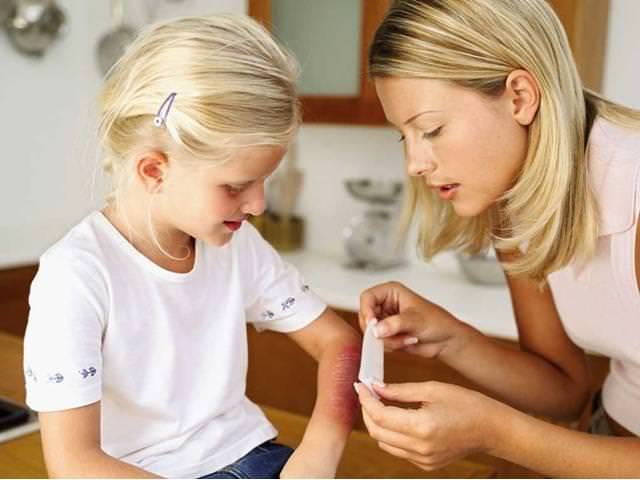
Very often, young children get burns at home - parents do not always have time to keep an eye on their inquisitive kids
IMPORTANT! Traditional medicine recipes can only be used to treat minor burns. Injuries of 2, 3 and 4 degrees of severity require professional therapy.
Sunburn: features
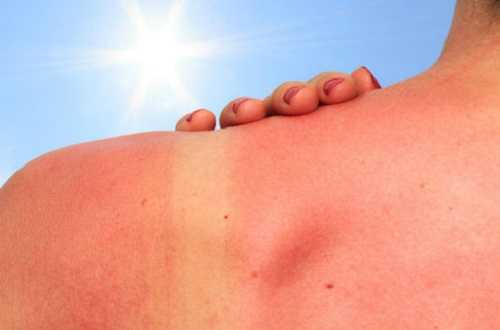
Skin damage from intense ultraviolet exposure occurs during prolonged exposure to the sun or solarium. The peculiarity of this injury is the large area of damage and the superficial degree of damage.
Sunburns in children and adults are dangerous if they are accompanied by heatstroke - a special condition of dysfunction of thermoregulation.
Sunburned skin and heatstroke are not synonymous concepts. The first is characterized by the manifestation of signs corresponding to the I-II severity of the burn:
- redness of the skin;
- severe pain and burning;
- the appearance of blisters on protruding parts of the body.
Heat stroke is always accompanied by neurological symptoms, since the pathology develops as a result of disruption of the thermoregulation center in the brain:
- confusion or loss of consciousness;
- convulsions;
- inhibition of reactions;
- dilated pupils;
- breathing problems;
- vomit;
- chills.
An important difference: sunburn occurs only when the skin is directly exposed to ultraviolet radiation; heat stroke can occur without the influence of direct sunlight: in a stuffy room, car, subway, etc. and is not necessarily accompanied by skin damage.
First aid for sunburn is to cool the body with a shower and move to a cool, shaded place. Moisturizing the skin with milk or body lotion helps to speed up skin healing and reduce pain; Panthenol spray has proven itself excellent for this purpose.
The use of sour cream and kefir in such cases is not allowed, since these products contribute to a pH shift towards acidification, which is an irritating factor.
Burns received in a solarium can damage tissues much deeper and lead to the development of shock. There are known cases of death after an extensive second-degree burn obtained from artificial tanning. In the open sun, a lethal dose of ultraviolet radiation can be obtained by continuous exposure to the scorching rays for eight hours.
Danger zones: burns of the face, neck, chest

Injuries to the upper half of the body are considered the most dangerous, since damage can affect important functional organs: the respiratory tract, eyes, ears.
- A burn to the chest, as a rule, spreads to the neck area, which can lead to difficulty breathing; increasing swelling prevents the passage of oxygen through the respiratory tract. In case of deep tissue damage in these areas, emergency necrotomy is performed in order to prevent the development of a fatal complication.
- With thermal damage to the face, the pain syndrome is most pronounced, and a strong reflex closure of the eyelids also occurs, which, as a rule, prevents damage to the conjunctiva. Swelling of the eyelids and blepharospasm greatly complicate the diagnosis of corneal damage, so such burns must be observed by a doctor.
In case of contact with an open flame, injury to the conducting respiratory tract poses a great threat.
Symptoms of damage in this case will be:
- singed nose hairs;
- swelling of the mucous membrane;
- difficulty breathing;
- dry cough;
- burning sensation when breathing.
Burns in these areas are considered severe and require specialized treatment, so if you receive them, you should immediately consult a doctor.
Classification by location of injury
Thermal burn code according to ICD 10 (T20-T32)
Features of burns are reflected in ICD-10 based on the location of the injury:
- abdominal walls, back surface, chest, groin area - ICD-10 T21;
- shoulders, upper limbs - ICD-10 T22;
- head, neck - ICD-10 T20;
- wrists, hands - ICD-10 T22;
- hips, lower extremities - ICD-10 T24;
- foot, ankle - ICD-10 T24.

Wounds to the eyes, mouth, and throat are considered separately. Damage often covers different zones; they are classified as unspecified localization - ICD-30.
An extensive burn (more than 10% of the skin) is a dangerous factor, even in cases of shallow damage to the epidermis. A threat to human life arises when more than a third of the total surface area is affected. Tissue destruction is visually assessed by location, indicating the percentage of damage from the total area of the skin of the body. The size of the victim's palm is approximately 1%; this guideline allows us to determine the scale of the injury received.
Deep damage is typical for areas of the inner surfaces of the arms and thighs, where the skin is thinner. Burns are especially dangerous for delicate children's skin.
